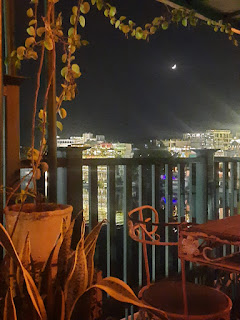Badrinath, the land of lore
Namastay everyone, hope you're doing well. Thanks to cyclone Mandous, it's quite cold and drizzly in Bangalore, making me feel sick. The rains haven't disappeared from the scene this year and it's time to ask, "Atithi tum kab jaoge? (When will leave o guest?)". After all, too much of anything is good for nothing! Let me recount about my visit to Badrinath (Uttarakhand), one of the four holy places of the legendary Chardham yatra, as I snuggle up in bed with my warm blanket. Being feverish, that's the only thing that I can enjoy doing, after two long days of hard work.
Personally, the idea of visiting holy places to get all my wishes fulfilled and sins washed doesn't go well with my philosophy. It might have applied in the olden days, when to reach such places, people really had to go through a lot of hardships which would teach them some important life lessons, and make them better people. But with money and technology at one's disposal, one has easy access to these overcrowded and now commercialized places. They make me feel more suffocated than sanctified. I prefer the secluded, calm and clean temples, which give me a sense of serenity.
We visited Badrinath temple on our driver's suggestion. It being one of the holy sites of chardham yatra, we too felt obliged to visit the same given that we were staying very close to it.
 |
| Badrinath is situated at the foot of the the peaks (as seen from Auli's base) |
We left for Badrinath from Auli after having our breakfast and reached there in around 2 hours. After about 15-20 minutes of us joining the Darshana queue, the sanctum's doors were closed for Bhog. The queue was disassembled at the open area in front of the sanctum, and crowds became unorderly. As more and more people kept joining the queue, the area started getting overcrowded. The bright afternoon sun and hunger started making people quite restless. Having small children with us and fearing a crowd surge, we felt like getting out. But there wasn't any. Finally, when the doors reopened, everybody got so desperate to get in that the situation became very chaotic. Protecting the kids from the crowd, when we finally reached the sanctum, we hardly got a chance to take Darshana due to people pushing us from behind. By the time we got out, the kids were hurt, hungry, and exhausted. I'm sure that each one of us must have gone through this kind of experience at least once. I wish that something can be done to change the scenario.
 |
| Badrinath Temple (pc Abhijeet) |
Although the experience of visiting the temple wasn't that pleasant, I found the tales associated with it quite intriguing. Let me share some of them with you.
As described here, Skanda Purana mentions that the idol of Lord Badrinath was recovered by Adi Sri Shankara from Narada Kunda, which is just a stone's throw from the temple and was re-enshrined in the 8th century A. D. The Purana further goes to say that, “There are several sacred shrines in heaven, on earth, and in hell; but there is no shrine like Badrinath.” It is also said that the reason behind the reestablishment was to revive the lost glory of Hinduism.
Do you know the origins of the name of this place? The name originates from the Sanskrit word badri (बद्री), which is a type of wild berry. We also call it ber (बेर) in Hindi and bor (बोर) in Marathi, Jujube in English, and baare hannu (ಬಾರೆ ಹಣ್ಣು) in Kannada. It is said that, once Lord Vishnu sat in penance in the mountains under harsh weathers. His consort Goddess Laxmi took the form of a jujube tree and shaded him from the surroundings. Pleased by the devotion of Lakshmi, Vishnu named the place Badrika Ashrama, which eventually took the name Badrinath. According to Atkinson (1979), the place used to be a jujube forest and hence the name.
Nara and Narayana, the emanations of Lord Vishnu, and the sons of Dharma and Ahimsa, took multiple avataras on Earth for the welfare of mankind. According to Vamana Purana, they spent their lifetime at Badrinath performing deep austerities. During one such period of deep penances and austerities, Lord Indra got concerned (as usual). He sent Kamadeva, Vasanta, and Apsaras to distract them. In response to this mischief, sage Narayana placed a flower on his thigh, and transformed it into Urvashi (Uru-thigh, Urvashi is the one who is born from the thigh). Urvashi was far more superior to the Apsaras, and was sent to Indralok with Kamadeva, who was then ashamed of the act. Did you know about this fascinating story about Urvashi?
The town of Badrinath finds its mention in many such Hindu scriptures. Great sages like Kapila Muni, Gautam, and Kashyap have performed penance here. Medieval religious scholars like Adi Shankaracharya have frequented this place for learning and meditation. Many sadhus continue to do even today. If only I was fortunate enough to feel the divinity of this place? Hoping to experience the same in the future, I take your leave with this thought to ponder.
"Once you choose hope, anything is possible!" - Christopher Reeve (Amarican Actor who played Superman)
Shalom!


.jpeg)
Comments
Post a Comment